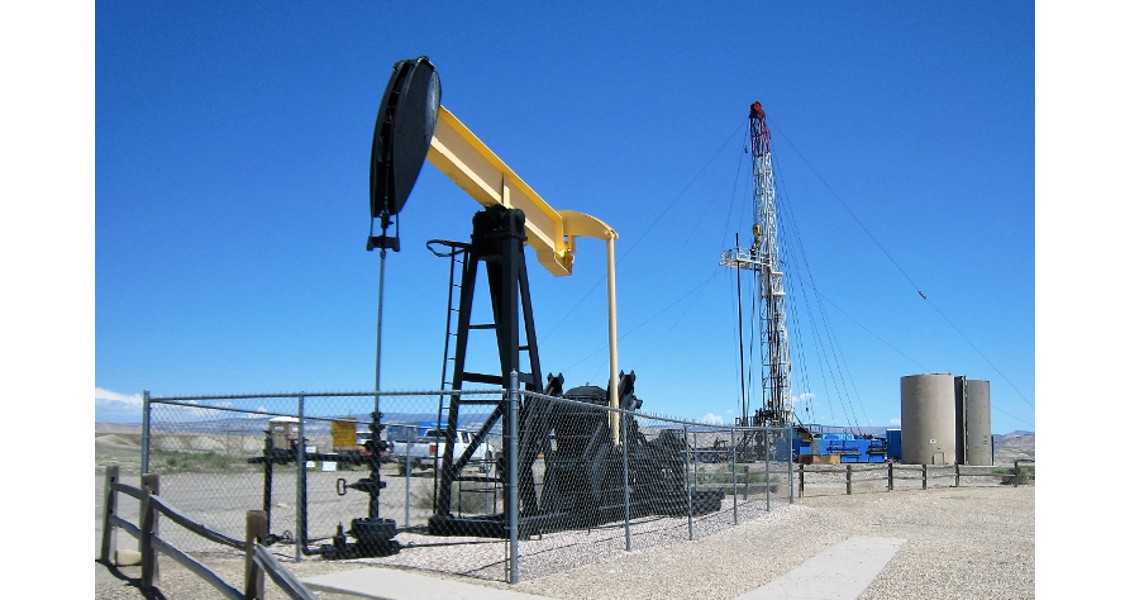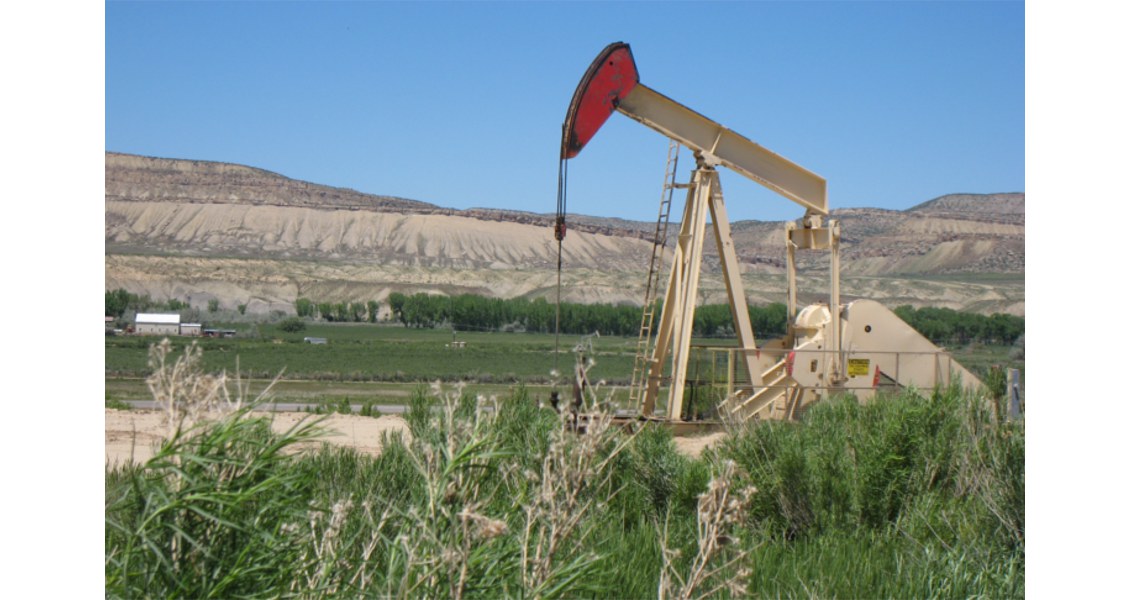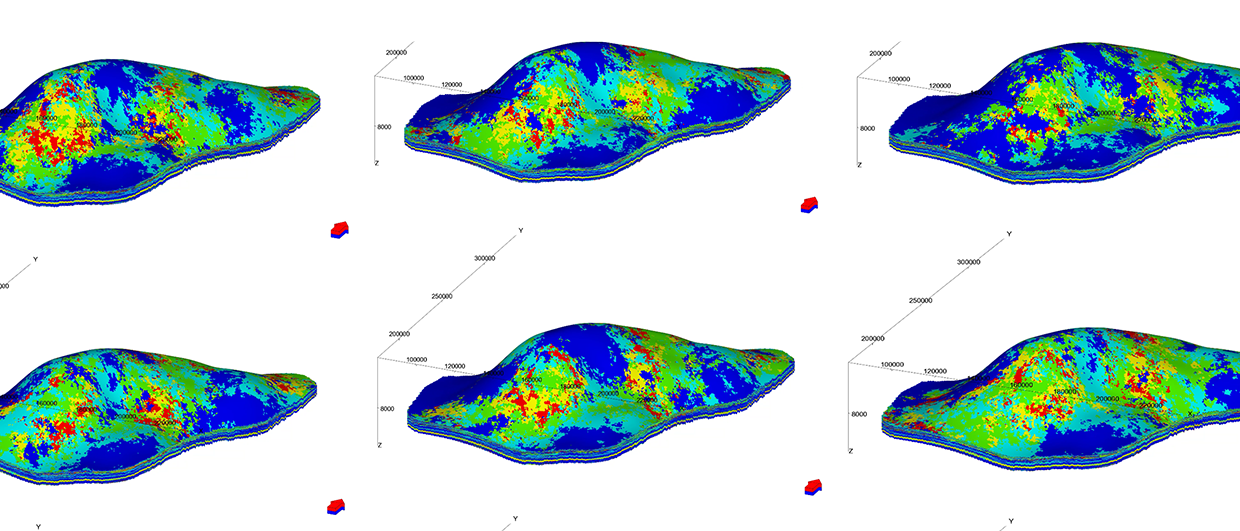One of the oldest and largest conventional oil fields in the US Rocky Mountain region, Rangely is in a remote north-west corner of Colorado along the White River. This area was originally referred to as Raven Park in the early 1870s by C. A. White, a geologist with the Hayden Survey. The upper portion of the White River valley was formed by erosion of the relatively soft Upper Cretaceous Mancos Shale on the crest of a large anticlinal structure. The discovery of an oil seep in a spring along the north bank of the White River brought attention to the area as a potential oil field and a number of companies were organised among the local residents to prospect and develop it. Drilling started in 1901 with oil discovered in the Mancos Shale at depths of 150 to 520m. By 1903, 13 different companies had drilled the Rangely field, yielding just 10 barrels per day.
Almost 30 years after those first disappointing wells were drilled, Raven A-1 was spudded by the California Company (now Chevron) in 1931. It took more than a year to drill down to an oil saturated sandstone at a depth of 1,931m. In 1933, the well tested at 230 bopd from the Weber sandstone and remained shut in for 10 years after producing 8,000 bo. The well had discovered a huge field with more than 1.9 billion barrels oil-in-place, but it would take World War II to increase the demand for oil before the remote field would be developed. Since then, the field has undergone a multitude of projects that have slowed production decline and greatly increased the overall oil recovery. Chevron learned early on that to effectively produce this complex reservoir, they had to rely on the operations personnel to closely monitor each well in order to make timely adjustments to their production programme.
Production History
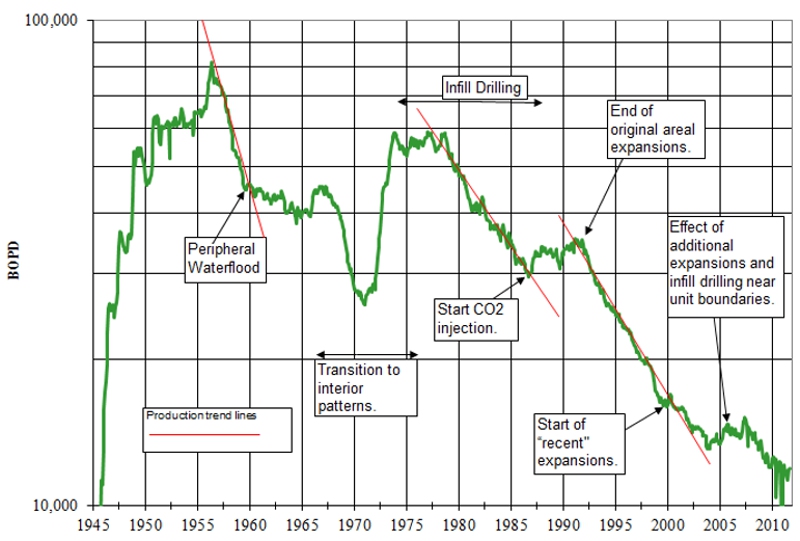 A number of projects designed to bring more oil to the surface have kept the Rangely field economic for 70 years. (Source: Chevron)Development drilling began in April 1944 and after just a year and a half, 182 wells had penetrated the productive Weber sandstone. At one point in 1946, 54 rigs were operating simultaneously, and by 1949, 478 wells on 40-acre spacing (~0.16 km2) had been drilled. Produced gas injection began in 1950 to help maintain reservoir pressure.
A number of projects designed to bring more oil to the surface have kept the Rangely field economic for 70 years. (Source: Chevron)Development drilling began in April 1944 and after just a year and a half, 182 wells had penetrated the productive Weber sandstone. At one point in 1946, 54 rigs were operating simultaneously, and by 1949, 478 wells on 40-acre spacing (~0.16 km2) had been drilled. Produced gas injection began in 1950 to help maintain reservoir pressure.
Further declines in reservoir pressure led to a full scale water flood operation in 1958, with peak production reaching 82,000 bopd. Infill drilling started in the early 1970s. The water flood continued until a tertiary recovery programme using carbon dioxide (CO2) injection was initiated in 1986. Additional expansions and infill drilling, including a pilot project testing 10-acre (~0.04 km2) spacing, have continued, with the most recent new well drilled in 2013.
All of the secondary and tertiary production programmes, as well as infill drilling, are designed to recover additional oil-in-place and extend the life of the field. The water flood programme was carried out by drilling additional wells where water is injected into the reservoir, maintaining reservoir pressure and pushing oil toward production wells. The CO2 injection tertiary recovery programme resulted in some surprises and a change in the original design plans.
The Rangely CO2 Project
Before starting tertiary recovery at Rangely, Chevron expected to recover 821 MMbo with the water flood – about 43% of the 1.9 Bbo originally in place. They also expected to gain another 118 MMbo by adding CO2 injection. (Note: The field is still going strong, producing 11,000 bopd and 1,200 bpd NGLs.) Chevron had a large net gain in production but also one that required the investment of millions of dollars. Operating costs increased as CO2 reacted with water to form carbonic acid, necessitating all the equipment used in producing this field to be corrosion resistant.
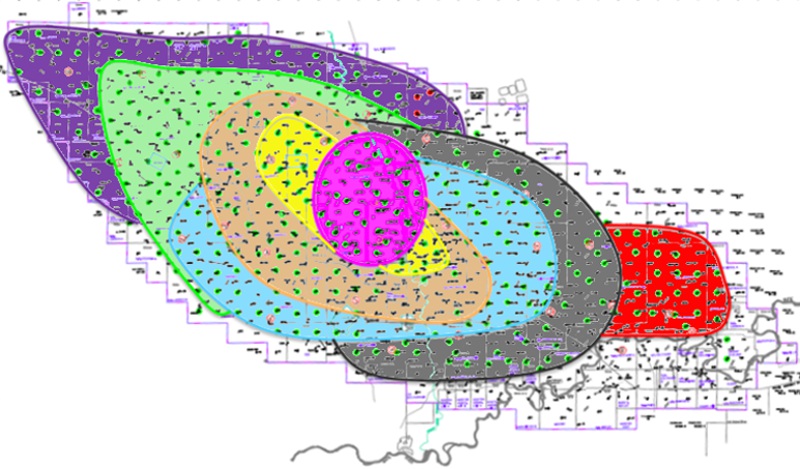 CO2 injection started in the pink circle and has expanded out across the field during the past 30 years. (Source: Chevron)The CO2 is purchased from a gas sweetening plant near La Barge in southwest Wyoming and is transported 77 km via pipeline to Rock Springs, Wyoming. Chevron’s pipeline then moves the gas another 208 km to the Rangely field. Pipeline and facility construction started in 1984. The company originally purchased 75 MMcfpd of CO2, peaking in 1990 at 150 MMcfpd before dropping to the current 30–36 MMcfgd.
CO2 injection started in the pink circle and has expanded out across the field during the past 30 years. (Source: Chevron)The CO2 is purchased from a gas sweetening plant near La Barge in southwest Wyoming and is transported 77 km via pipeline to Rock Springs, Wyoming. Chevron’s pipeline then moves the gas another 208 km to the Rangely field. Pipeline and facility construction started in 1984. The company originally purchased 75 MMcfpd of CO2, peaking in 1990 at 150 MMcfpd before dropping to the current 30–36 MMcfgd.
CO2 injection into an oil pool increases oil recovery because of the modifications it creates in the crude. Some of the more important changes include: reducing the oil viscosity, which makes the oil less resistant to flow; swelling the crude to push more oil out of the rock; and increasing gas pressure which also pushes more oil out of the rock and to the well bore.
CO2 and water are pumped into the Weber sandstone in alternating cycles (water alternating gas or WAG), sweeping more oil to the producing wells. Production consists of a variety of petroleum components, water, and gases. The production stream is separated into the various parts to recover the petroleum while the CO2 and water are treated and reinjected. The field now has ~400 active producing wells and ~275 injector wells.
Teamwork
Chevron’s Erik Woodward, the Rangely Technical Team Lead, and James Cooper, a petroleum engineer at Rangely, explain: “A typical WAG injection programme consists of alternating slugs of water and gas injected into the reservoir. Injected gas acts as the solvent or mobilising agent but it does a poor job of displacing oil. Injected water helps to displace the oil and improve sweep efficiency. In most fields, parameters that are critical in affecting the enhanced oil recovery included the WAG ratio, injection rates, cycle, well spacing, gas breakthrough, reservoir pressure, and sweep efficiency. These factors are constantly monitored by the technical team and operations personnel at the field. Typical programmes in other CO2 floods call for a ‘WAG’ ranging from once a month to every six months. The complex heterogeneity of the Weber reservoir at Rangely requires a significantly higher WAG tempo in order to keep optimised facilities and maximise production. We are currently doing between 25 and 60 WAGs per week and over 3,000 in a year for the entire field. This takes a good operations team monitoring daily changes in pressures and production rates so that the technical team can make adjustments to the WAG programme.”
To keep this field operating efficiently, Chevron employs about 50 operations personnel, with four ‘WAGgers’ just to keep track of and to make the 3,000+ WAGs each year. On a daily basis, the WAGgers monitor pressures and injection rates and relay that information to the Rangely Technical Team, which consists of a team leader, an injection engineer, geologist, reservoir engineer, and up to five production engineers.
“The WAG with CO2 injection is a complicated process. Results can vary from expectations and the team has to make changes to the programme. We communicate closely with the operations personnel to identify trends quickly, in order to make the best reservoir production plans,” says Erik Woodward. “The interaction with Operations is one of the most critical components of efficiently executing the WAGs and changes must be clearly communicated to Operations, who make it all happen.”
Now and Beyond
Necessary changes to the WAG programme included tapering. The original programme called for a 1:1 ratio of water to gas. The revised WAG programme uses more water in ratios of 2:1 and 3:1 and reduced half-cycle slug sizes to control gas production. Initial design called for half-cycle slug size of 1.5% hydrocarbon pore volume (HCPV) and now varies between 0.25 and 1.5. Close monitoring and infield drilling have increased the sweep and made the CO2 flood an economically successful project. Technical innovation and the flexibility to make quick and sometimes dramatic changes to the flood have been critical in field development.
Chevron is always looking for opportunities to increase production in the field. Some of the more obvious projects include continuing to tweak the WAG, more infield drilling in underdeveloped areas of the field which may include 10-acre spacing, switching injectors to producers, and improving and increasing fracturing operations.
One thing is certain: Erik and the entire Rangely team will keep all options open to employ new technology and innovations to maintain the Rangely field production.


